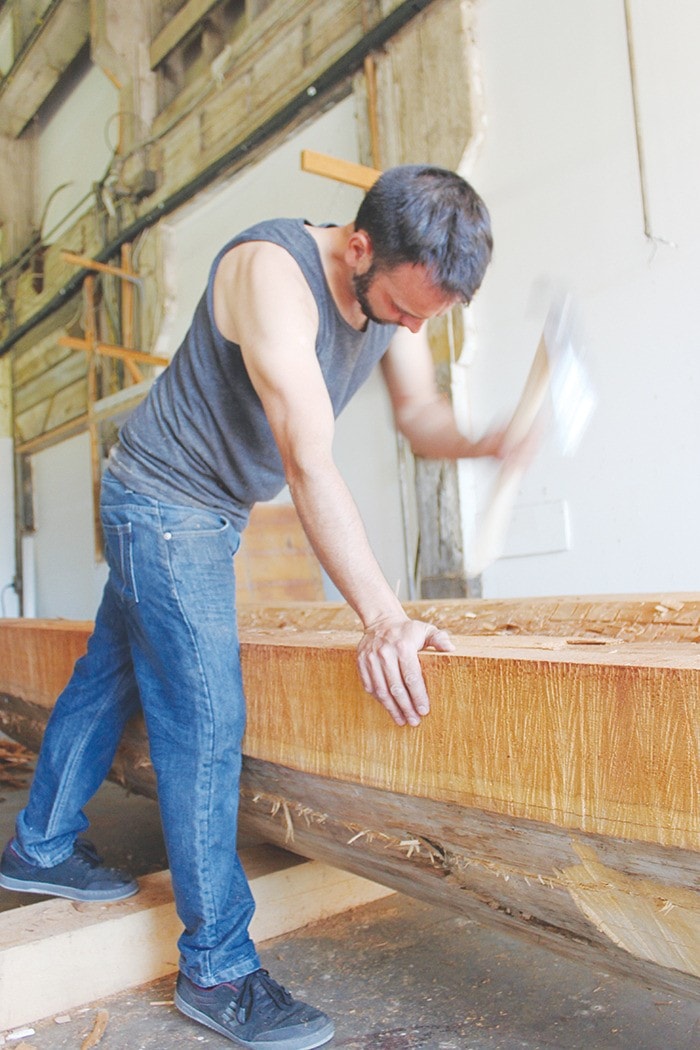When there’s no reporters around, pestering him with questions, and John Marston is alone with the gigantic half rounds of cedar he’s shaping into works of art, he’s often praying to the tree that is allowing him to make real a human vision.
It’s a state of mind – a form of meditation, he says – that is part of the very long process Marston is engaged in at the Waterfront Gallery, where he is hand-carving two immense pieces of cedar. If you can’t immerse yourself spiritually in the art – be in harmony with the routines of chipping, chiselling and shaping for hours, days, months – you could never do what he does: create magnificent art out of magnificent trees.
The logs he’s squaring up, in what used to be a locomotive and truck repair shop behind the Waterfront Gallery, are 16 feet long by three feet wide – two halves of a single split length of cedar. He could be working on them for six months to a year.
“Eventually they have to be full-time to get them done,” he said. “They require that amount of time.”
Carving this big requires a vision, and Marston has encapsulated his in a one-twelfth scale model of what the finished work he’s presently squaring and prepping will look like – one inch in the model for every foot of the finished work.
As a First Nations artist steeped in his people’s traditions, but surrounded by a world where history is being rewritten at an ever accelerating pace, Marston has two approaches to his sculptures.
“A lot of the carvings have historical significance of our history here in Ladysmith or on the Coast,” he said. “Some of the carvings, they tell stories of old legends that have been passed down for thousands of years.”
Then there are works that blend contemporary with traditional.
“Some pieces are completely modern concepts, ideas that I as a First Nations person deal with every day in our modern world. It’s an exploration of both ideas: the traditional concepts and where we are today.”
No matter which approach Marston takes, his view is always from the persepctive of a First Nations artist exploring and explaining his world through art. “The history and the culture always stays,” he said. “That part of it always stays with the work, even if it is considered a contemporary piece.
“Some artists, we’re telling our stories through our work, but we’re also always having to tell our ancestors’ stories. We’re always trying to find ways to meld them both together in a way that’s honorable.”
Marston has an aesthetic in mind for the work. “I think of nice, soft, golden lines throughout the work so when you look at it you still feel like you’re standing in front of an ancient cedar tree,” he said.
This isn’t the first time Marston and the Waterfront Gallery have teamed up. In 2008 he, his brother Luke and a group of Victoria artists mounted an international Crossing the Pacific exhibition at the Canadian Embassy in Japan. The show was also hosted in Ladysmith at the Waterfront Gallery and at the Victoria Art Gallery.
He wants to build on that relationship.
“I’ve spent a lot of time over the years, working with art galleries across Canada and in Vancouver,” Marston said, “and I kept thinking we could show our work here and spend time in our own community, but we also had to create a space and a venue to do that.
“That’s important for myself, and for our Nation and for our community.”
The cavernous machine shop space he’s working in now, as an artist in residence with the Waterfront Gallery holds some personal history for Marston. His father and grandfather worked in the building. “They both worked here when this place was bustling with machinery and all sorts of things.”
Just how long Marston will be working on his sculptures at the Waterfront Gallery is an open ended question. But while he’s there as artist in residence, he’s happy to talk to people and answer questions about what he’s doing. For more information about the Open Studio, call 250-245-1252.
